Research on the Impact of Carbon Emissions and Spatial Form of Town Construction Land: A Study of Macheng, China
Abstract
:1. Introduction
2. Materials and Methods
2.1. Study Area and Data Sources
2.2. Methods
2.2.1. Classification and Screening of Town Construction Land
2.2.2. Screening and Quantification of Spatial Form Elements
2.2.3. Calculation of Carbon Emissions
3. Results
3.1. The Relationship between Spatial Form Elements and Carbon Emissions from Town Construction Land
3.2. Analysis of the Impact of Spatial Form Elements on Town Construction Land
3.2.1. The impact of spatial form elements on residential land
3.2.2. The Impact of Spatial Form Elements on Public Land
3.3. Random Forest Regression of Spatial Form and Carbon Emissions from Town Construction Land
3.3.1. Model Regression Results for Residential Land
3.3.2. Model Regression Results for Public Land
4. Discussion
4.1. Analysis of Research Findings
- Regarding the nature of the land, no energy consumption, such as gas or biomass (firewood), is involved. Urban residential land produces lower carbon emissions than rural residential land, and public land, commercial service land, administrative office land, municipal utilities land, and medical land have higher carbon emissions. In comparison, educational land and cultural land have lower carbon emissions [57].
- When the floor area ratio is more significant than 1.01, the carbon emissions of residential land are correspondingly lower; when the floor area ratio is(0, 0.38) and (1.18, 1.6), the carbon emissions of public land are lower. The analysis shows that the impact of the floor area ratio on carbon emissions is mainly due to building height. A higher floor area ratio allows for a higher building height and a wider surface area, which makes it easier to obtain more light [58], thus reducing energy consumption for lighting and heating.
- In line with other academic studies, we found that the higher the building density, the lower the carbon emissions [59]. When the building density is more significant than 0.40, the carbon emissions of residential land are correspondingly lower; at a building density (0, 0.14) and (0.29, 0.35), the carbon emissions of public land are lower. The analysis shows that building density affects the wind–heat cycle within a specific geographical area. Firstly, a high building density will make it difficult to dissipate heat inside urban settlements, thus aggravating the local heat island effect and increasing the cooling energy demand in summer; secondly, a lower building density is conducive to the formation of more ventilation corridors between buildings, thus facilitating natural indoor ventilation and reducing ventilation and cooling energy consumption.
- An increase in population density can be effective in reducing carbon emissions. This study argues that when population density increases, it creates a spatial sharing of resources and increases the efficiency of energy use, thus reducing carbon emissions [60].
- A reduction in building shape coefficient can reduce carbon emissions from the town construction land. Analysis shows that the smaller the building bulk factor, the higher the thermal storage capacity of the house and the lower the carbon emissions caused by energy consumption. A more exposed surface area, i.e., a more significant building bulk factor, will likely result in higher residential energy use [61].
- When the number of building storey is greater than 10, the carbon emissions from residential land decrease accordingly, while a decrease in the number of building storeys reduces the carbon emissions from public land. This study concludes that as the average number of building storeys in a residential area increases, the neighborhood’s building shape coefficient decreases, which reduces the heat dissipated by the building envelope [62].
- When the orientation of the building is more significant than 0.2645, the carbon emissions of the residential land are reduced accordingly. The analysis shows that the south façade receives the most solar radiation, and the energy consumption of the south-facing households is lower than that of the other households. Therefore, the carbon emissions decrease with the increase in the building orientation when the building orientation reaches a specific value [63]. However, the increasing trend of carbon emissions in this study, which increases and then decreases with the orientation of the building, differs from that of other scholars.
- Similar to other scholarly studies, we found that building area has a strong correlation with energy consumption [64]. A reduction in building area can significantly reduce carbon emissions from town construction land; a high building area also means a high cooling or heating demand, and a high building area also has an impact on the light, heat radiation, and airflow of the site; for example, a high building area increases the building surface area of the site to absorb solar radiation, which, in turn, affects the cooling or heating energy consumption of the site by influencing the regional microclimate [65].
- When the age of the building was completed after 2010, the carbon emissions from residential land were significantly reduced. This study concluded that the building envelope, building materials, HVAC system, and the form of the building are important influencing factors for building energy consumption and further affect the carbon emissions of town construction land [66]. Older dwellings were largely unconsidered for building energy efficiency due to the conditions at the time, with more significant heat transfer coefficients in walls and windows and a higher overall building energy consumption.
4.2. Subsection
5. Conclusions and Suggestions
5.1. Conclusions
5.2. Optimization Suggestions
Author Contributions
Funding
Data Availability Statement
Conflicts of Interest
References
- Mi, Z.; Zheng, J.; Meng, J.; Zheng, H.; Li, X.; Coffman, D.M.; Woltjer, J.; Wang, S.; Guan, D. Carbon emissions of cities from a consumption-based perspective. Appl. Energy 2019, 235, 509–518. [Google Scholar] [CrossRef] [Green Version]
- Regering, S. Ett Klimatpolitiskt Ramverk för Sverige. 2017. Available online: https://www.regeringen.se/rattsliga-dokument/proposition/2017/03/prop.-201617146 (accessed on 20 June 2023).
- pour la Biodiversité, A.F. Ma Commune Sans Pesticide. Le Guide Des Solutions; Ministère de la Transition Ecologique et Solidaire: Paris, France, 2018. [Google Scholar]
- Department for Business; Energy & Industrial Strategy; The Rt Hon Chris Skidmore MP. UK Becomes First Major Economy to Pass Net Zero Emissions Law. 2019. Available online: https://www.gov.uk/government/news/uk-becomes-first-major-economy-to-pass-net-zero-emissions-law (accessed on 24 June 2023).
- Response, C.C. Amendment Act 2019; NZ Government: Wellington, UK, 2019. [Google Scholar]
- Salvia, M.; Reckien, D.; Pietrapertosa, F.; Eckersley, P.; Spyridaki, N.-A.; Krook-Riekkola, A.; Olazabal, M.; Hurtado, S.D.G.; Simoes, S.G.; Geneletti, D. Will climate mitigation ambitions lead to carbon neutrality? An analysis of the local-level plans of 327 cities in the EU. Renew. Sustain. Energy Rev. 2021, 135, 110253. [Google Scholar] [CrossRef]
- Ministry of Commerce of the People’s Republic of China. Opinions of the Central Committee of the CPC and the State Council on Carbon Dioxide Peaking and Carbon Neutrality in Full and Faithful Implementation of the New Development Philosophy; Ministry of Commerce of the People’s Republic of China: Beijing, China, 2021. [Google Scholar]
- Wang, M.; Wang, Y.; Wu, Y.; Yue, X.; Wang, M.; Hu, P. Detecting Differences in the Impact of Construction Land Types on Carbon Emissions: A Case Study of Southwest China. Land 2022, 11, 719. [Google Scholar] [CrossRef]
- Goodall, C. How to Live a Low-Carbon Life: The Individual’s Guide to Stopping Climate Change; Earthscan: London, UK, 2007. [Google Scholar]
- Liu, L.-C.; Wu, G.; Wang, J.-N.; Wei, Y.-M. China’s carbon emissions from urban and rural households during 1992–2007. J. Clean. Prod. 2011, 19, 1754–1762. [Google Scholar] [CrossRef]
- OECD; IEA. Energy and Air Pollution: World Energy Outlook Special Report 2016; IEA: Paris, France, 2016. [Google Scholar]
- Zhang, Z.; Li, Y.; Zhang, Y.; Wu, X.; Di, H.; Zhang, X. Investigation and Analysis on Energy Consumption of Existing Public Buildings in Hot Summer and Warm Winter Zones. Build. Energy Effic. 2020, 48, 11–15. [Google Scholar] [CrossRef]
- Murti, I.; Nugrahani, E.; Setyawan, D.; Alexfan, M. Study on energy efficiency, carbon reduction and human comfort in Universitas Internasional Semen Indonesia. IOP Conf. Ser. Earth Environ. Sci. 2019, 259, 012020. [Google Scholar] [CrossRef]
- Naji, S.; Shamshirband, S.; Basser, H.; Keivani, A.; Alengaram, U.J.; Jumaat, M.Z.; Petković, D. Application of adaptive neuro-fuzzy methodology for estimating building energy consumption. Renew. Sustain. Energy Rev. 2016, 53, 1520–1528. [Google Scholar] [CrossRef]
- Wu, W.; Song, Y.; Hong, Z.; Lu, Y. Research of the Influence of Community Form on residential Energy Consumption: A Case Study on Ningbo City. Urban Dev. Stud. 2018, 15–20. [Google Scholar] [CrossRef]
- Shi, K.; Xu, T.; Li, Y.; Chen, Z.; Gong, W.; Wu, J.; Yu, B. Effects of urban forms on CO2 emissions in China from a multi-perspective analysis. J. Environ. Manag. 2020, 262, 110300. [Google Scholar] [CrossRef]
- Carpio, M.; Carrasco, D. Impact of shape factor on energy demand, CO2 emissions and energy cost of residential buildings in cold oceanic climates: Case study of south chile. Sustainability 2021, 13, 9491. [Google Scholar] [CrossRef]
- Sun, C.; Zhang, Y.; Ma, W.; Wu, R.; Wang, S. The Impacts of Urban Form on Carbon Emissions: A Comprehensive Review. Land 2022, 11, 1430. [Google Scholar] [CrossRef]
- Mao, Y.; Gong, X.; Ye, Y. Carbon emission-based measurement of floor area ratio bonus for residential green buildings in China. J. Green Build. 2018, 13, 84–97. [Google Scholar] [CrossRef]
- Liang, D.; Lu, H.; Guan, Y.; Feng, L.; He, L.; Qiu, L.; Lu, J. Population density regulation may mitigate the imbalance between anthropogenic carbon emissions and vegetation carbon sequestration. Sustain. Cities Soc. 2023, 92, 104502. [Google Scholar] [CrossRef]
- Natanian, J.; Aleksandrowicz, O.; Auer, T. A parametric approach to optimizing urban form, energy balance and environmental quality: The case of Mediterranean districts. Appl. Energy 2019, 254, 113637. [Google Scholar] [CrossRef]
- Oh, M.; Jang, K.M.; Kim, Y. Empirical analysis of building energy consumption and urban form in a large city: A case of Seoul, South Korea. Energy Build. 2021, 245, 111046. [Google Scholar] [CrossRef]
- Xu, C.; Haase, D.; Su, M.; Yang, Z. The impact of urban compactness on energy-related greenhouse gas emissions across EU member states: Population density vs physical compactness. Appl. Energy 2019, 254, 113671. [Google Scholar] [CrossRef]
- Faroughi, M.; Karimimoshaver, M.; Aram, F.; Solgi, E.; Mosavi, A.; Nabipour, N.; Chau, K.-W. Computational modeling of land surface temperature using remote sensing data to investigate the spatial arrangement of buildings and energy consumption relationship. Eng. Appl. Comput. Fluid Mech. 2020, 14, 254–270. [Google Scholar] [CrossRef] [Green Version]
- Shen, Y.-S.; Lin, Y.-C.; Cui, S.; Li, Y.; Zhai, X. Crucial factors of the built environment for mitigating carbon emissions. Sci. Total Environ. 2022, 806, 150864. [Google Scholar] [CrossRef]
- Gudipudi, R.; Fluschnik, T.; Ros, A.G.C.; Walther, C.; Kropp, J.P. City density and CO2 efficiency. Energy Policy 2016, 91, 352–361. [Google Scholar] [CrossRef]
- Lin, J.; Lu, S.; He, X.; Wang, F. Analyzing the impact of three-dimensional building structure on CO2 emissions based on random forest regression. Energy 2021, 236, 121502. [Google Scholar] [CrossRef]
- Xia, C.; Xiang, M.; Fang, K.; Li, Y.; Ye, Y.; Shi, Z.; Liu, J. Spatial-temporal distribution of carbon emissions by daily travel and its response to urban form: A case study of Hangzhou, China. J. Clean. Prod. 2020, 257, 120797. [Google Scholar] [CrossRef]
- Hong, S.; Hui, E.C.-m.; Lin, Y. Relationship between urban spatial structure and carbon emissions: A literature review. Ecol. Indic. 2022, 144, 109456. [Google Scholar] [CrossRef]
- Urban and Rural Planning Terminology Review Committee. Chinese Terms in Urban And Rural Planning; Science Press: Beijing, China, 2021. [Google Scholar]
- Shang, Z. A Multi-Scale Study of the Evolution of Urban Spatial Form; Southeast University Press: Dhaka, Bangladesh, 2015. [Google Scholar]
- He, Y.; Wang, R.; Yang, W.; Guo, R.; Gao, Y. Technology definition and method integration in low carbon city planning. Constr. Sci. Technol. 2012, 48–53. [Google Scholar] [CrossRef]
- Ewing, R.; Cervero, R. Travel and the built environment: A meta-analysis. J. Am. Plan. Assoc. 2010, 76, 265–294. [Google Scholar] [CrossRef]
- Ewing, R.; Bartholomew, K.; Winkelman, S.; Walters, J.; Chen, D. Growing Cooler: The Evidence on Urban Development and Climate Change; Smart Growth America: Washington, DC, USA, 2009; Volume 25, pp. 6–13. [Google Scholar]
- Cervero, R.; Kockelman, K. Travel demand and the 3Ds: Density, diversity, and design. Transp. Res. Part D Transp. Environ. 1997, 2, 199–219. [Google Scholar] [CrossRef]
- Xia, C.; Zhang, A.; Yeh, A.G. The varying relationships between multidimensional urban form and urban vitality in Chinese megacities: Insights from a comparative analysis. Ann. Am. Assoc. Geogr. 2022, 112, 141–166. [Google Scholar] [CrossRef]
- Alawadi, K.; Khanal, A.; Abdelfattah, R.S. Typological index of alleyways: Mapping the pattern of a forgotten urban form element. J. Urban Des. 2023, 28, 199–224. [Google Scholar] [CrossRef]
- Javanroodi, K.; Mahdavinejad, M.; Nik, V.M. Impacts of urban morphology on reducing cooling load and increasing ventilation potential in hot-arid climate. Appl. Energy 2018, 231, 714–746. [Google Scholar] [CrossRef]
- Ou, J.; Liu, X.; Li, X.; Chen, Y. Quantifying the relationship between urban forms and carbon emissions using panel data analysis. Landsc. Ecol. 2013, 28, 1889–1907. [Google Scholar] [CrossRef]
- Rong, P.; Zhang, Y.; Qin, Y.; Liu, G.; Liu, R. Spatial differentiation of carbon emissions from residential energy consumption: A case study in Kaifeng, China. J. Environ. Manag. 2020, 271, 110895. [Google Scholar] [CrossRef]
- Zhang, X.; Yan, F.; Liu, H.; Qiao, Z. Towards low carbon cities: A machine learning method for predicting urban blocks carbon emissions (UBCE) based on built environment factors (BEF) in Changxing City, China. Sustain. Cities Soc. 2021, 69, 102875. [Google Scholar] [CrossRef]
- Alhorr, Y.; Eliskandarani, E.; Elsarrag, E. Approaches to reducing carbon dioxide emissions in the built environment: Low carbon cities. Int. J. Sustain. Built Environ. 2014, 3, 167–178. [Google Scholar] [CrossRef] [Green Version]
- Zheng, S.; Huang, Y.; Sun, Y. Effects of urban form on carbon emissions in china: Implications for low-carbon urban planning. Land 2022, 11, 1343. [Google Scholar] [CrossRef]
- Newman, P.W.; Kenworthy, J.R. Gasoline consumption and cities: A comparison of US cities with a global survey. J. Am. Plan. Assoc. 1989, 55, 24–37. [Google Scholar] [CrossRef]
- Yi, Y.; Ma, S.; Guan, W.; Li, K. An empirical study on the relationship between urban spatial form and CO2 in Chinese cities. Sustainability 2017, 9, 672. [Google Scholar] [CrossRef] [Green Version]
- Li, J.; Lo, K.; Zhang, P.; Guo, M. Relationship between built environment, socio-economic factors and carbon emissions from shopping trip in Shenyang City, China. Chin. Geogr. Sci. 2017, 27, 722–734. [Google Scholar] [CrossRef]
- Li, X.; Yao, R.; Liu, M.; Costanzo, V.; Yu, W.; Wang, W.; Short, A.; Li, B. Developing urban residential reference buildings using clustering analysis of satellite images. Energy Build. 2018, 169, 417–429. [Google Scholar] [CrossRef]
- Wang, G.; Han, Q. Assessment of the relation between land use and carbon emission in Eindhoven, the Netherlands. J. Environ. Manag. 2019, 247, 413–424. [Google Scholar] [CrossRef]
- Zhang, Y.; Zhang, S.; Gong, Y. The Association between Carbon Emission and Urban Spatial Form—A Study of Zhuhai, China. Land 2023, 12, 720. [Google Scholar] [CrossRef]
- Filogamo, L.; Peri, G.; Rizzo, G.; Giaccone, A. On the classification of large residential buildings stocks by sample typologies for energy planning purposes. Appl. Energy 2014, 135, 825–835. [Google Scholar] [CrossRef]
- Liao, Q.; Zhang, X.; Zhao, H.; Liao, Y.; Li, P.; Liao, Y. Built Environment Factors (BEF) and Residential Land Carbon Emissions (RLCE). Buildings 2022, 12, 508. [Google Scholar] [CrossRef]
- Bringas, E.N.; Godawatte, G.A.G.R. Shedding light on the efforts into the rehabilitation of a major culprit of carbon emissions: A scientometric analysis of net-zero in the built environment sector. Energy Build. 2022, 266, 112119. [Google Scholar] [CrossRef]
- Li, X.; Yao, R.; Yu, W.; Meng, X.; Liu, M.; Short, A.; Li, B. Low carbon heating and cooling of residential buildings in cities in the hot summer and cold winter zone-A bottom-up engineering stock modeling approach. J. Clean. Prod. 2019, 220, 271–288. [Google Scholar] [CrossRef]
- Keoleian, G.A.; Blanchard, S.; Reppe, P. Life-cycle energy, costs, and strategies for improving a single-family house. J. Ind. Ecol. 2000, 4, 135–156. [Google Scholar] [CrossRef]
- Li, Y.; Gong, X.; Li, H. The Impact of External Insulation System Optimization on Building Life Cycle Energy Consumption. J. Henan Univ. Nat. Sci. 2016, 46, 226–231. [Google Scholar] [CrossRef]
- GB/T2589-2020; General Rules for Calculating Comprehensive Energy Consumption. Standardization Administration of the People’s Republic of China: Beijing, China, 2020.
- Research Center for Building Energy Efficiency, T.U. 2018 Annual Report on China Building Energy Efficiency; China Building Industry Press: Beijing, China, 2018. [Google Scholar]
- Dawodu, A.; Cheshmehzangi, A. Impact of floor area ratio (FAR) on energy consumption at meso scale in China: Case study of Ningbo. Energy Procedia 2017, 105, 3449–3455. [Google Scholar] [CrossRef]
- Deng, J.-Y.; Wong, N.H. Impact of urban canyon geometries on outdoor thermal comfort in central business districts. Sustain. Cities Soc. 2020, 53, 101966. [Google Scholar] [CrossRef]
- Timmons, D.; Zirogiannis, N.; Lutz, M. Location matters: Population density and carbon emissions from residential building energy use in the United States. Energy Res. Social Sci. 2016, 22, 137–146. [Google Scholar] [CrossRef]
- Ewing, R.; Rong, F. The impact of urban form on US residential energy use. Hous. Policy Debate 2008, 19, 1–30. [Google Scholar] [CrossRef]
- Yang, Z. Study and Analysis of the Impact of Block Spatial Form on Building Energy Consumption Based on DeST-h Model Simulation—Taking Taiyuan as an Example. Master’s Thesis, Taiyuan University of Technology, Taiyuan, China, 2019. [Google Scholar]
- Kohansal, M.E.; Akaf, H.R.; Gholami, J.; Moshari, S. Investigating the simultaneous effects of building orientation and thermal insulation on heating and cooling loads in different climate zones. Archit. Eng. Des. Manag. 2022, 18, 410–433. [Google Scholar] [CrossRef]
- Antonopoulos, C.; Trusty, A.; Shandas, V. The role of building characteristics, demographics, and urban heat islands in shaping residential energy use. City Environ. Interact. 2019, 3, 100021. [Google Scholar] [CrossRef]
- Chen, J.; Li, z.; Wang, X.; Ruan, Y. Optimal Urban Form Development Strategy for Residential Communities in Northern China: Based on an energy survey. Build. Energy Effic. 2018, 46, 8–14. [Google Scholar] [CrossRef]
- Liu, S.; Wang, J.; Xu, Y.; Zeng, H. Approaches of Buildings Carbon Mitigation Based on Spatial-Temporal Characteristics of Civil Building Energy Consumption: A Case Study on Shenzhen, China. Beijing Da Xue Xue Bao 2018, 54, 125–136. [Google Scholar] [CrossRef]
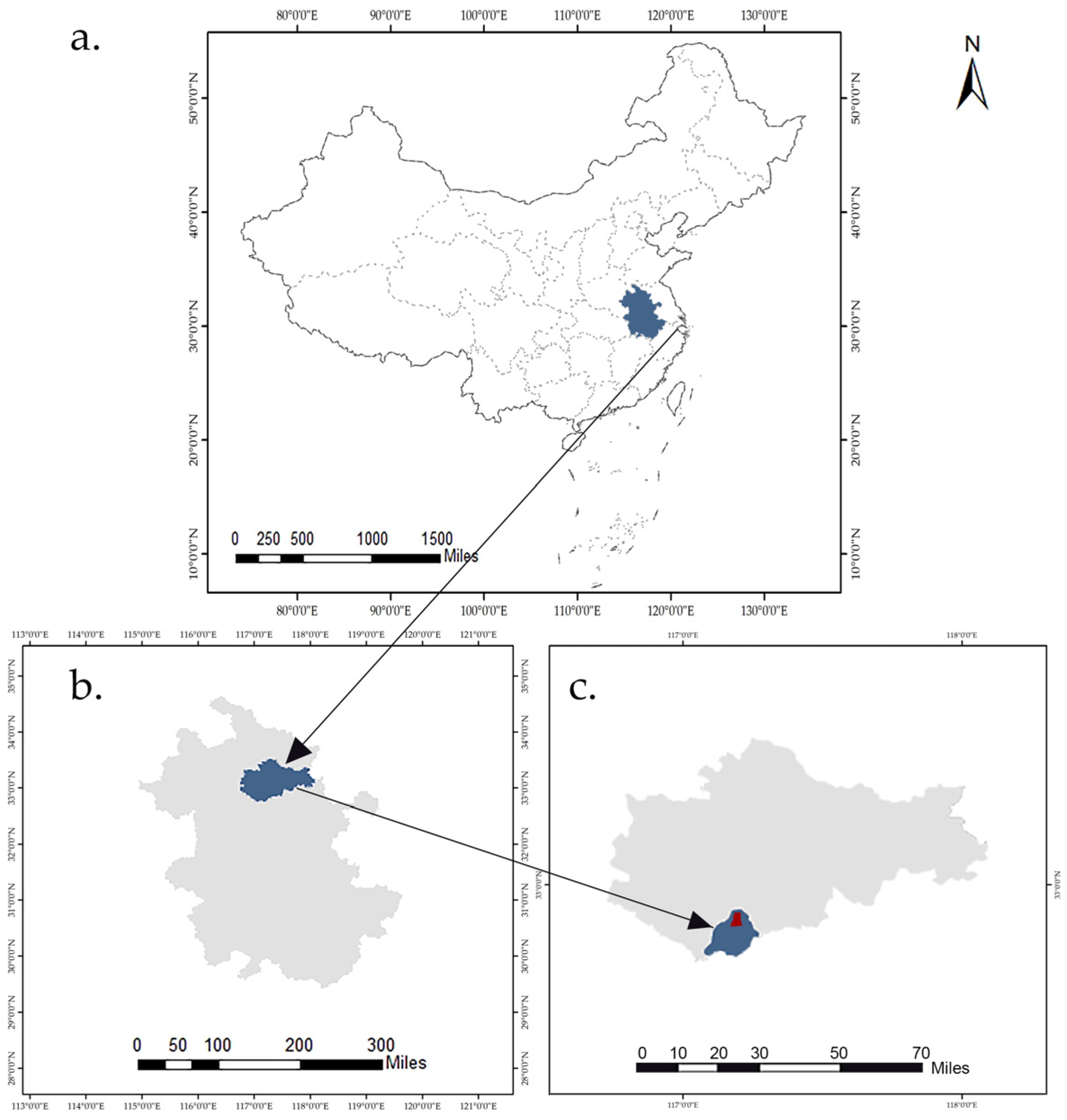

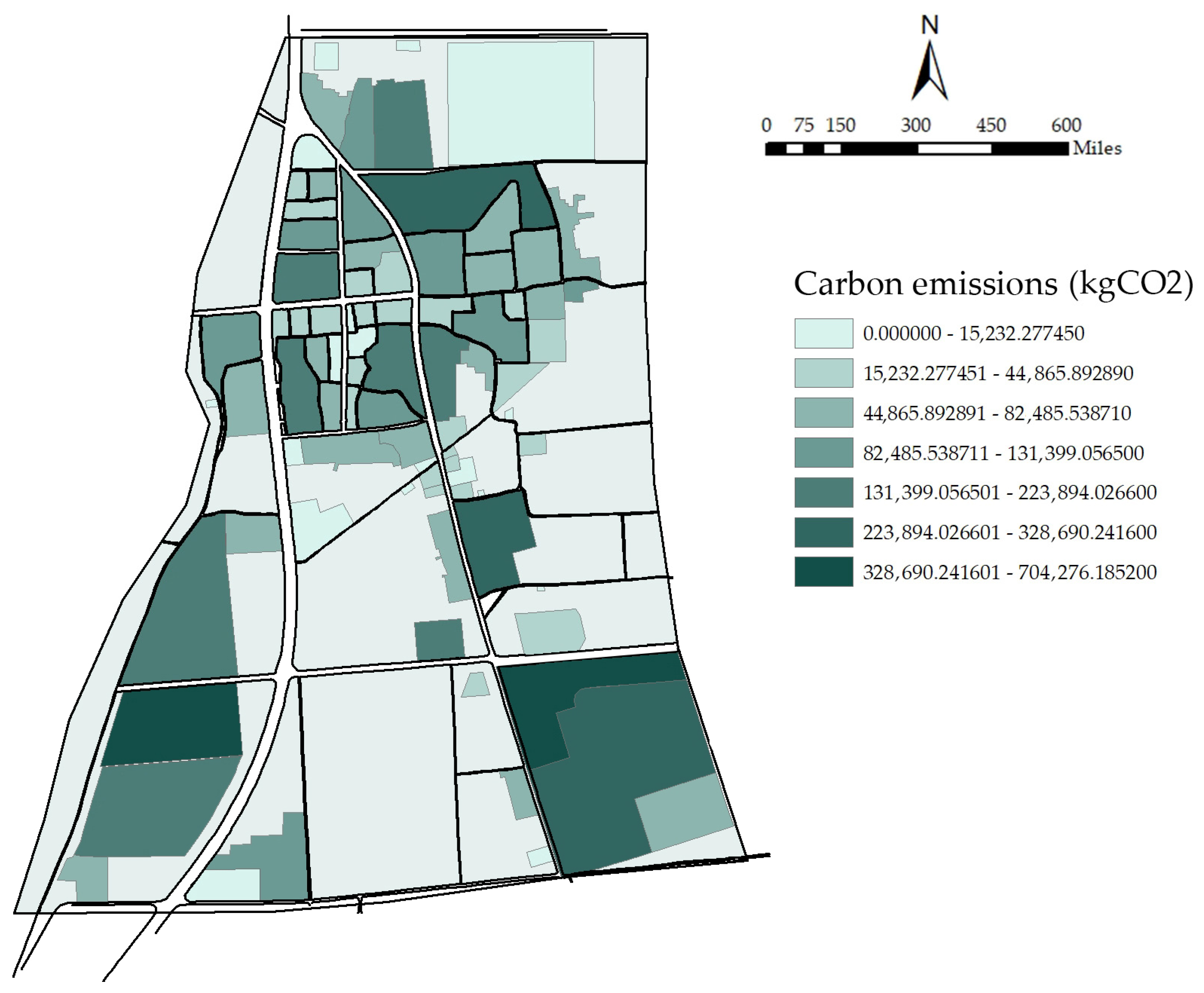


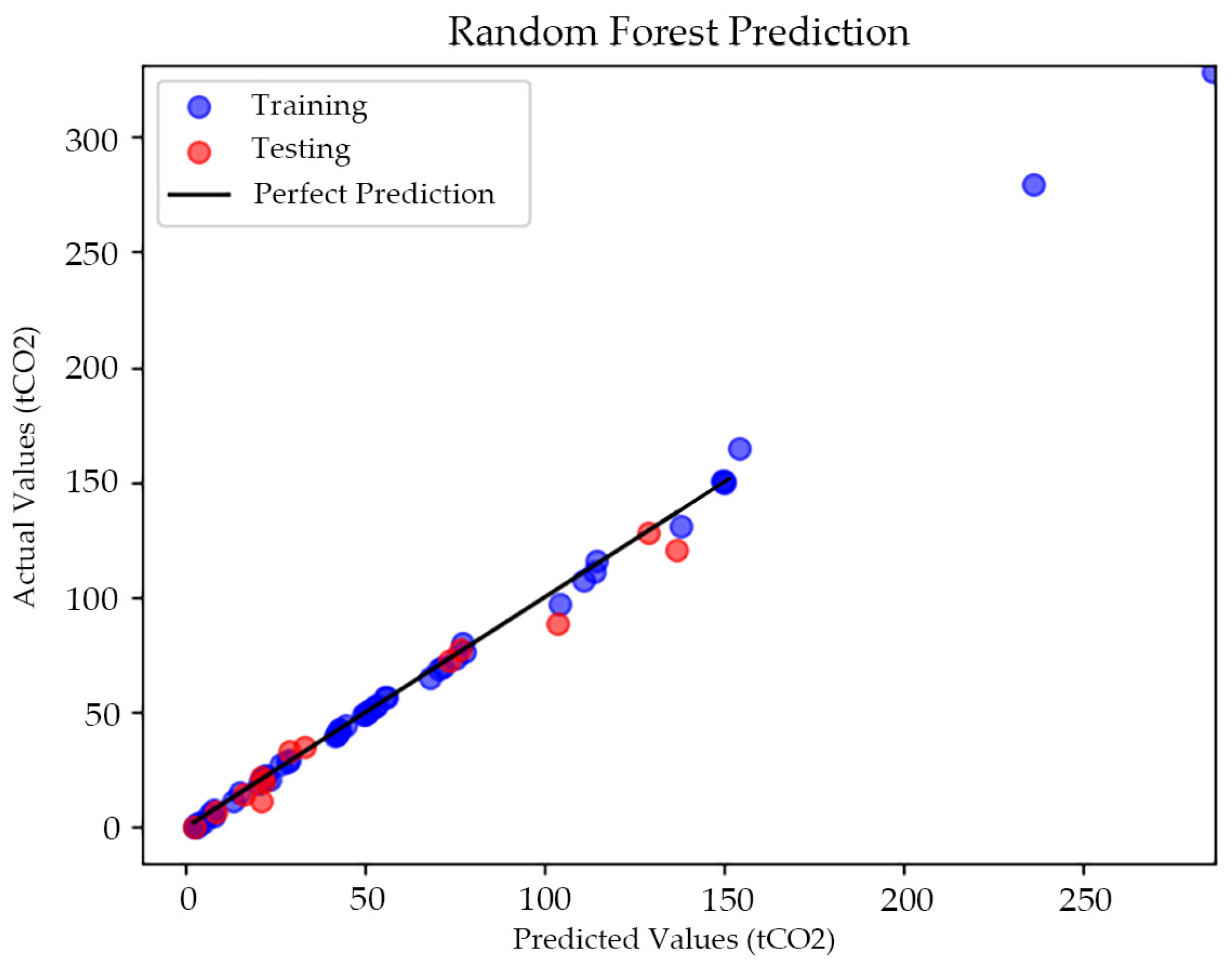
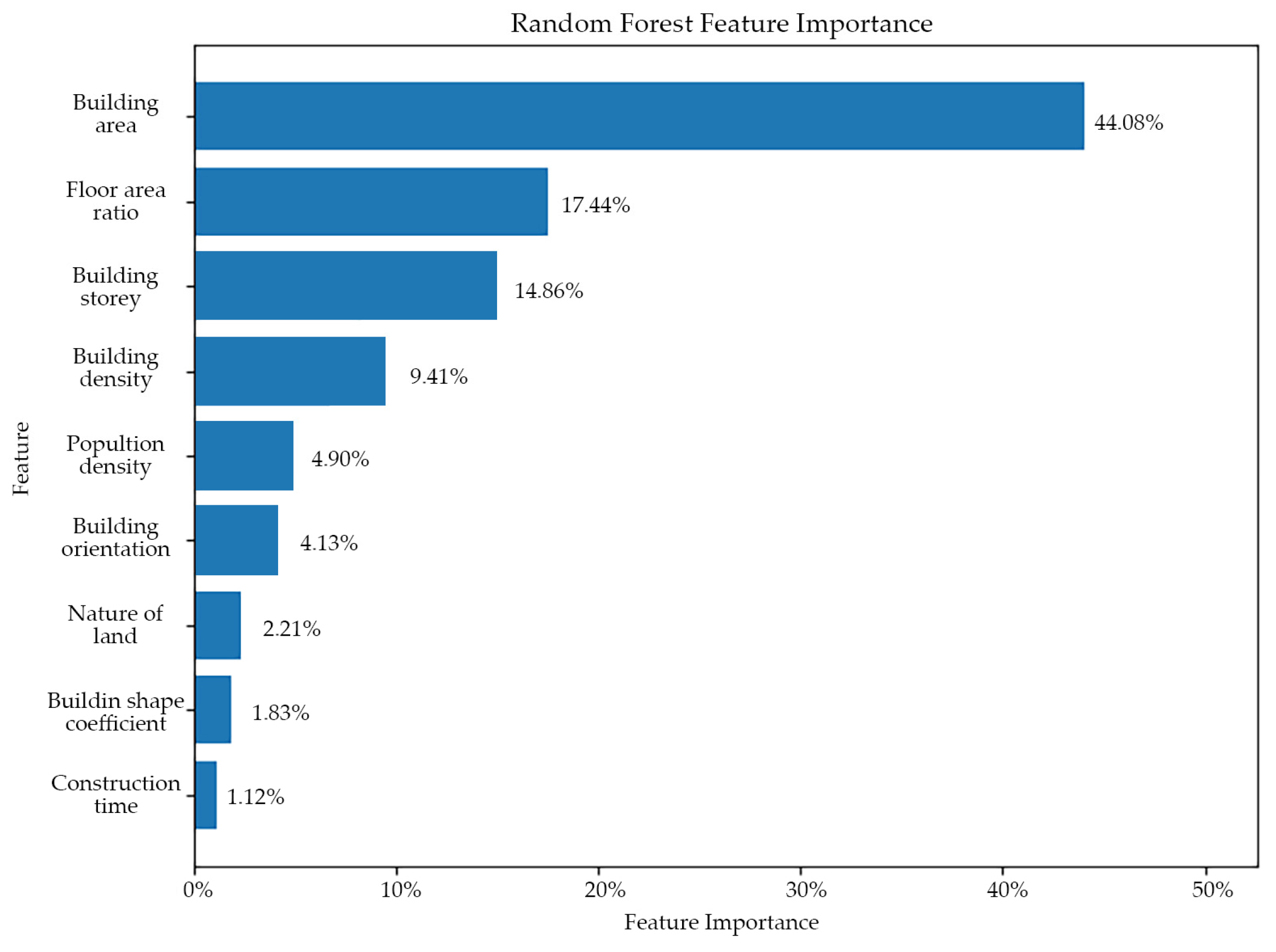


| Major Categories of Land Type | Medium Category of Land Type | Building Function |
|---|---|---|
| Residential land | Urban residential land | Urban residential buildings |
| Rural residential land | Rural residential buildings | |
| Public land | Commercial services land | Commercial services buildings |
| Administrative office land | Administrative office buildings | |
| Cultural land | Cultural buildings | |
| Educational land | Educational buildings | |
| Medical land | Medical buildings | |
| Municipal utilities land | Municipal utilities buildings | |
| Industrial storage land | Industrial land | Industrial production buildings |
| Production auxiliary room buildings | ||
| Storage land | Storage buildings |
| Spatial Pattern Indicators | Medium Category of Land Type |
|---|---|
| Floor area ratio | Javanroodi K (2018) [38], Mao, Y (2018) [19] |
| Building area | Jinpei Ou (2013) [39], Rong P (2020) [40], Zhang X (2021) [41], Alhorr Y (2014) [42], Zheng S (2022) [43] |
| Population density | PWG Newman (1989) [44], Y Yi (2017) [45], Alhorr Y (2014) [42], Li J (2017) [46], Liang, D (2023) [20] |
| Travel behavior | Jinpei Ou (2013) [39], Shen Y S (2022) [25], Li J (2017) [46] |
| Building density | Y Yi (2017) [45], Khaled Alawadi (2022) [37], Robert Cervero (1997) [35], Shen Y S (2022) [25], |
| Building storey | Zhang X (2021) [41], Alhorr Y (2014) [42], Li X (2018) [47] |
| Landscape metrics | G Wang (2019) [48], Y Zhang (2023) [49], Faroughi M (2020) [24] |
| Land use mix | Robert Cervero (1997) [35], Shen Y S (2022) [25] |
| Nature of land | Shen Y S (2022) [25], Zhang X (2021) [41], Alhorr Y (2014) [42], Filogamo L (2014) [50] |
| Building shape coefficient | Zhang X (2021) [41], Liao Q (2022) [51], Bringas E N (2022) [52], Javanroodi K (2018) [46], Carpio, M (2021) [17] |
| Construction time | Alhorr Y (2014) [42], Liao Q (2022) [51], Li X (2019) [53] |
| Building orientation | Sun, C (2022) [18], Oh, M (2021) [22], Filogamo L (2014) [50] |
| Classification of Elements | Elements of Spatial Form | Equation | Description | Definition |
|---|---|---|---|---|
| Land use elements | Nature of land | (i = 1,2,3 ……,9) | is the type of land use in category i; 1 is urban residential land; 2 is rural residential land; 3 is commercial services land; 4 is administrative office land; 5 is cultural land; 6 is educational land; 7 is medical land; 8 is municipal utilities land. | Nature of land refers to the specific use of a building site, as defined by the planning authority following the relevant land use classification standards and in response to urban and rural development needs. |
| Floor area ratio | A denotes the total building area within the plot; U denotes the total site area of the plot. | The floor area ratio refers to the ratio of the total building area to the site area within a plot. It provides a measure of the intensity of development of the land. | ||
| Land use mix | (i = 1,2,3 ……, n) | L is the number of building types; is the percentage of the building area of type i; n is the number of building types on the plot. | Land use mix refers to the proportion of other functional floor space mixed on a single nature of the building site. | |
| Building density | (i = 1,2,3 ……, n) | denotes the building footprint of the ith building on the plot; U indicates the total site area of the plot; n is the number of buildings on the plot. | Building density refers to the ratio of the total basement area of all buildings to the total site area within a certain plot of land, and can reflect the open space ratio and building density within a certain site. | |
| Population density | R denotes the number of people living on the plot; U denotes the total land area of the plot. | Population density refers to the number of people living on a unit of building land and is a true reflection of the distribution of the population within the building site. | ||
| Building elements | Building shape coefficient | S = (i = 1,2,3 ……, n) | B denotes the sum of the exterior areas of the building; T denotes the sum of the volume of the building. | The building shape coefficient is the ratio of the surface area of a building to its volume. At this stage, the building form factor is an essential parameter in characterizing the morphological features of a building and an important factor in the energy consumption of a building. |
| Building storey | C = (i = 1,2,3 ……, n) | denotes the number of storeys of the ith building; n is the number of building blocks on the plot. | Building storey refers to the natural storey of the building, which is generally calculated based on the interior floor level ±0 or more, including semi-basements with light windows above the exterior floor level, whose interior storey height is above 2.20 m (excluding 2.20 m); the natural storey is calculated, while others, such as attics and stairwells, are not calculated. | |
| Building orientation | denotes the length of the south elevation of the ith building; denotes the perimeter of the ith building; α indicates the angle between the south and north azimuth of the building. | Building orientation is the ratio of the length of the south-facing façade of a building plan to the perimeter of the building plan. In this study, building orientation refers to the ratio of the length of the south-facing elevation of all building planes on the site to the perimeter of all building planes. | ||
| Building area | (i = 1,2,3……,n) | denotes the building footprint of the ith building on the plot; denotes the building height of the ith building on the plot; n is the number of buildings on the site. | Building area refers to the total above-ground construction scale on a building site and represents, to some extent, the intensity of development on that building site. | |
| Construction time | (i = 1,2,3……,8) | denotes represents the construction time of the first building; 1 before 1980; 2 for the period 1980–2000; 3 for the period 2000–2010; 4:2010–2015; 5 for 2015–today. | Construction time refers to the development and construction of the building on which the construction site is located. In turn, the date of development and construction of a building specifies the materials used in its construction, the external envelope of the building, the form of the building, and other characteristics. |
| Energy Name | Low-Level Heat Content d | Carbon Content per Unit Calorific Value | Carbon Oxidation Rate (%) |
|---|---|---|---|
| Liquefied Petroleum Gas | 50.179 a | 0.0172 c | 98 b |
| Natural gas | 389.31 a | 0.01532 b | 99 b |
| Anthracite | 20.304 a | 0.02749 b | 94 b |
| Type | Variable Name | Residential Land | Public Land | ||
|---|---|---|---|---|---|
| Correlation Coefficient | Significance Level | Correlation Coefficient | Significance Level | ||
| Land use elements | Nature of land | −0.305 *** | 0.000 | −0.311 ** | - |
| Floor area ratio | 0.358 *** | 0.00 | 0.637 ** | 0.011 | |
| Land use mix | |||||
| Building density | 0.254 ** | 0.329 | 0.446 ** | 0.095 | |
| Population density | −0.252 ** | 0.027 | |||
| Building elements | Building shape coefficient | 0.34 *** | 0.007 | 0.757 *** | 0.001 |
| Building storeys | 0.596 *** | 0.000 | 0.542 *** | 0.000 | |
| Building orientation | 0.518 *** | 0.000 | |||
| Building area | 0.728 *** | 0.000 | 0.985 *** | 0.000 *** | |
| Construction time | 0.284 ** | 0.049 | |||
| Spatial Form Elements | Analysis Chart | |
|---|---|---|
| Land use elements | 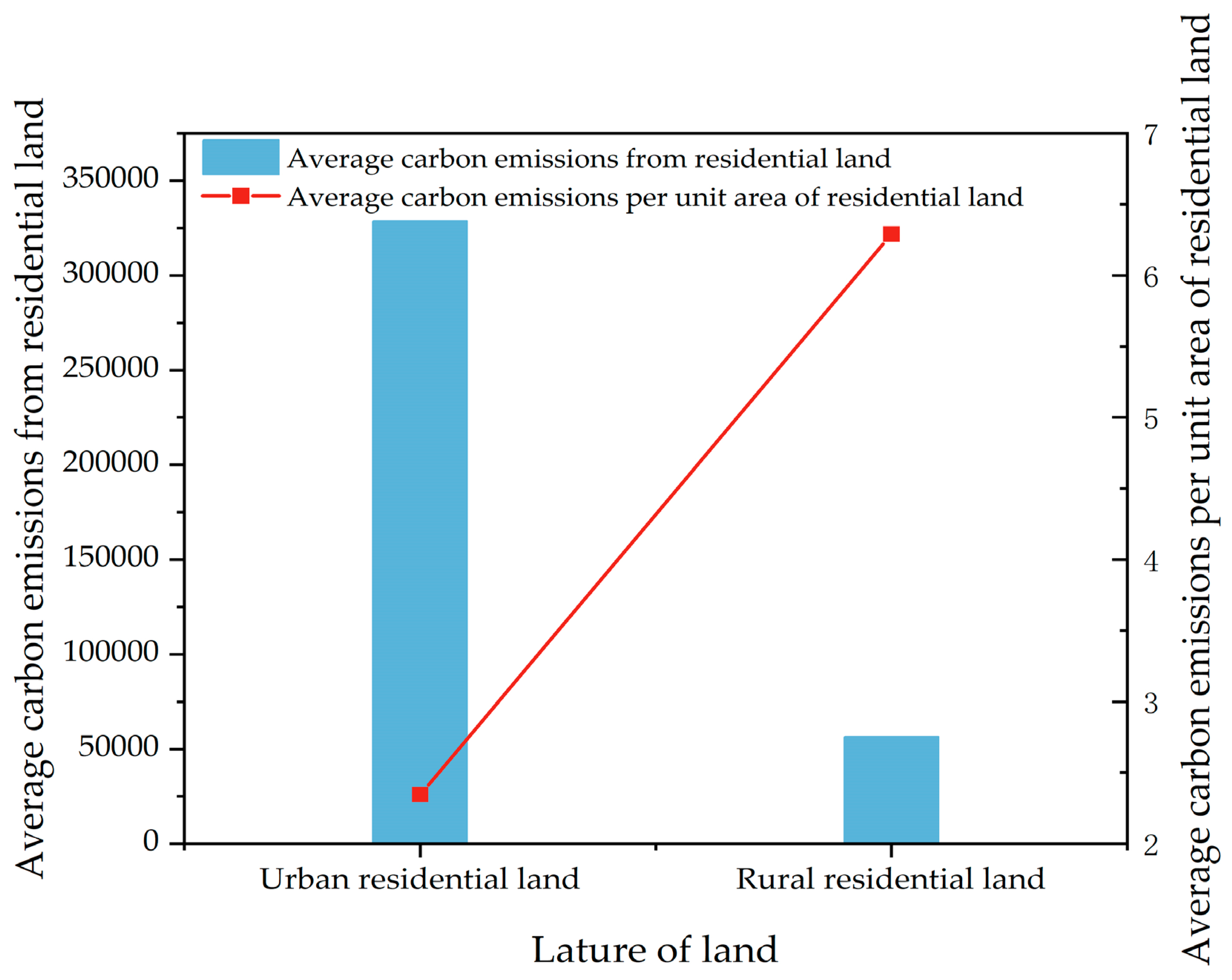 (1) Nature of land |  (2) Floor area ratio |
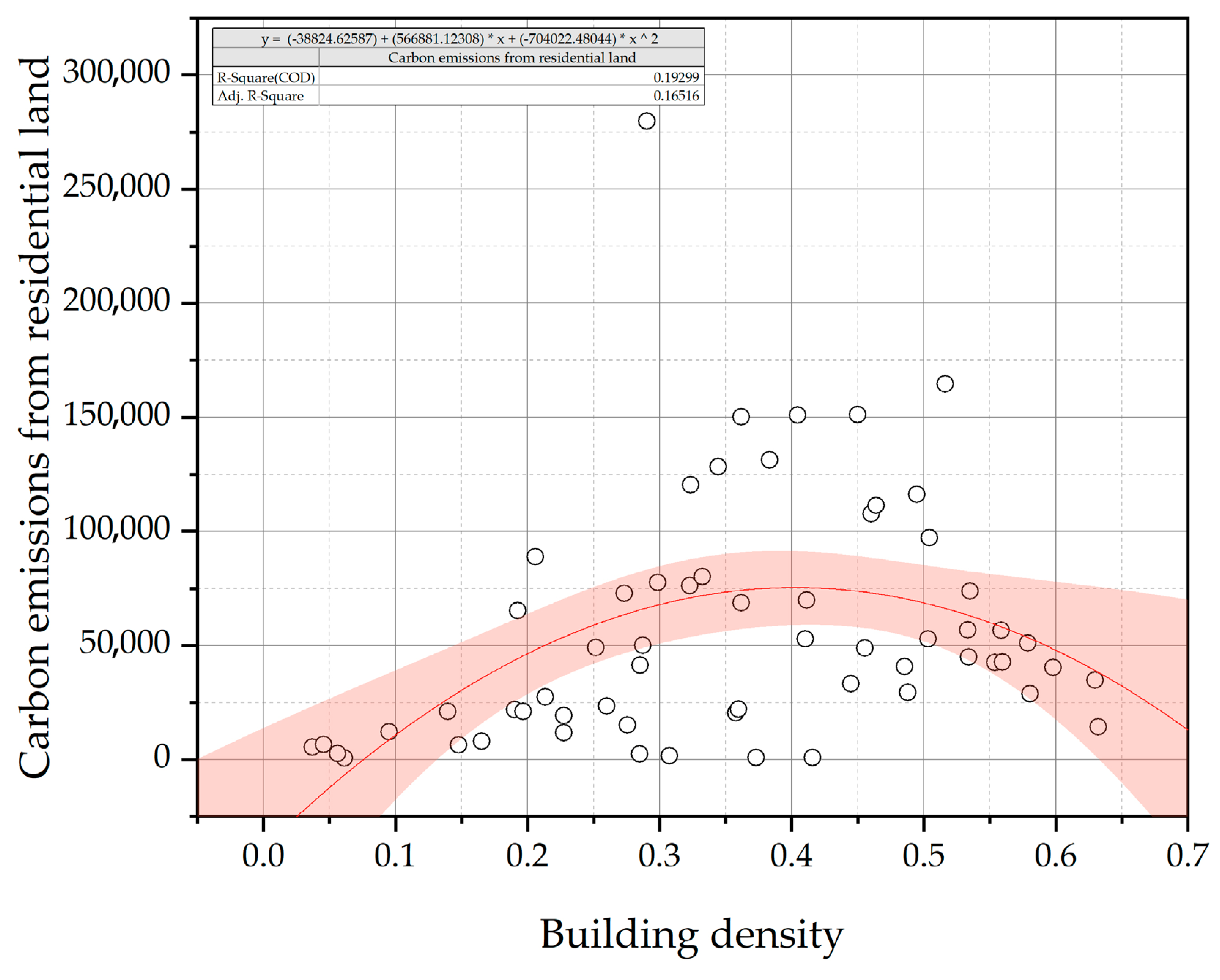 (3) Building density | 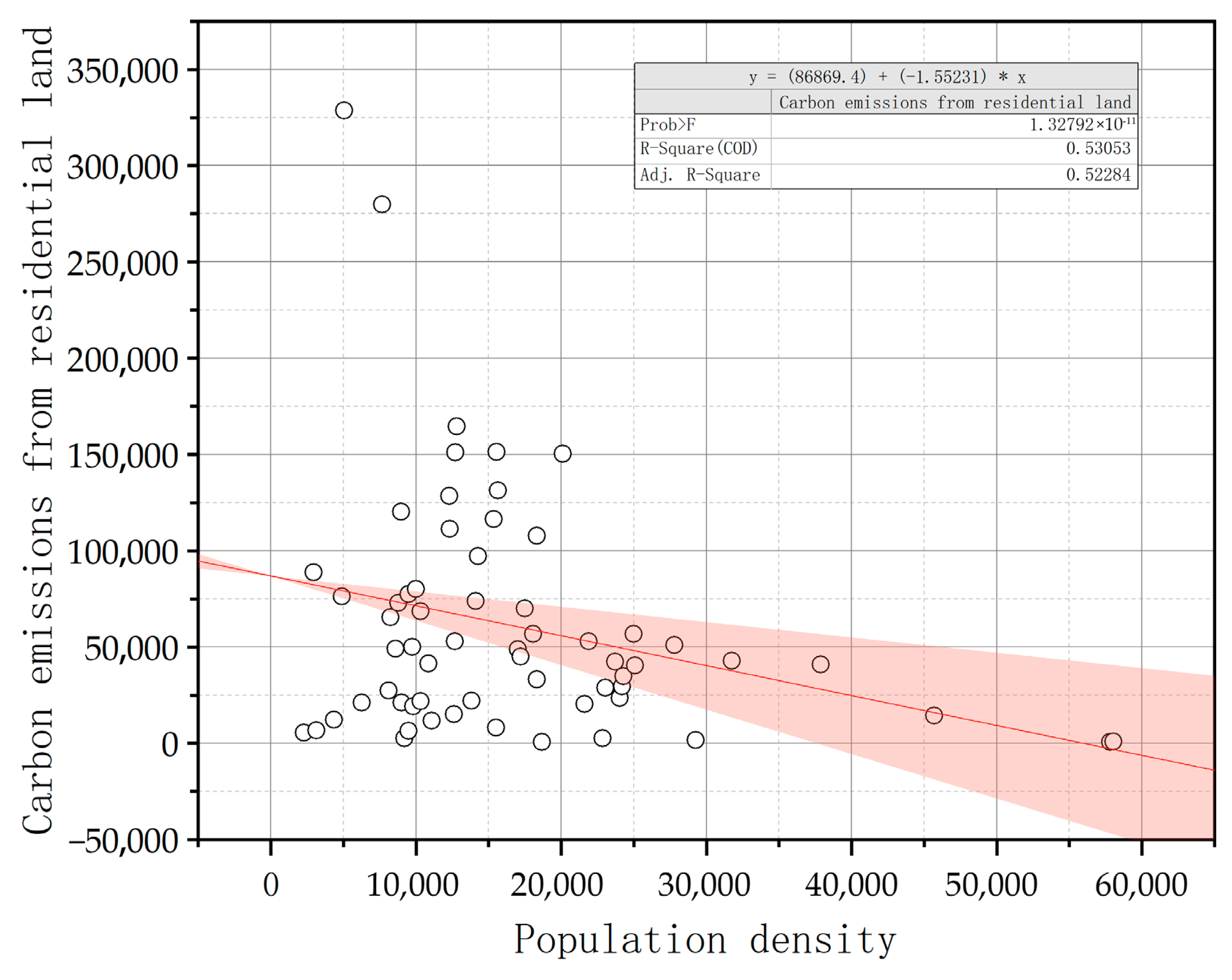 (4) Population density | |
| Building elements | 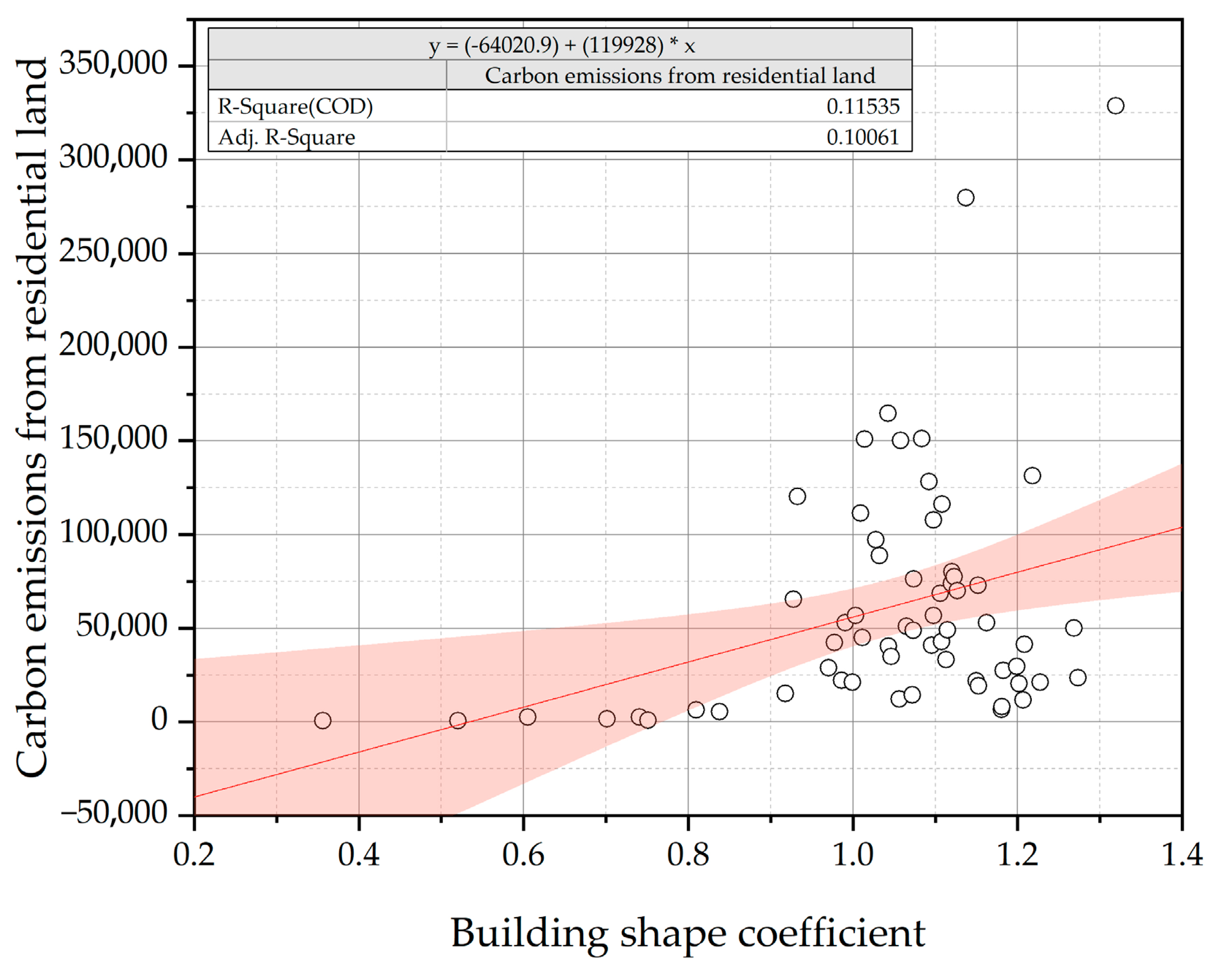 (5) Building shape coefficient | 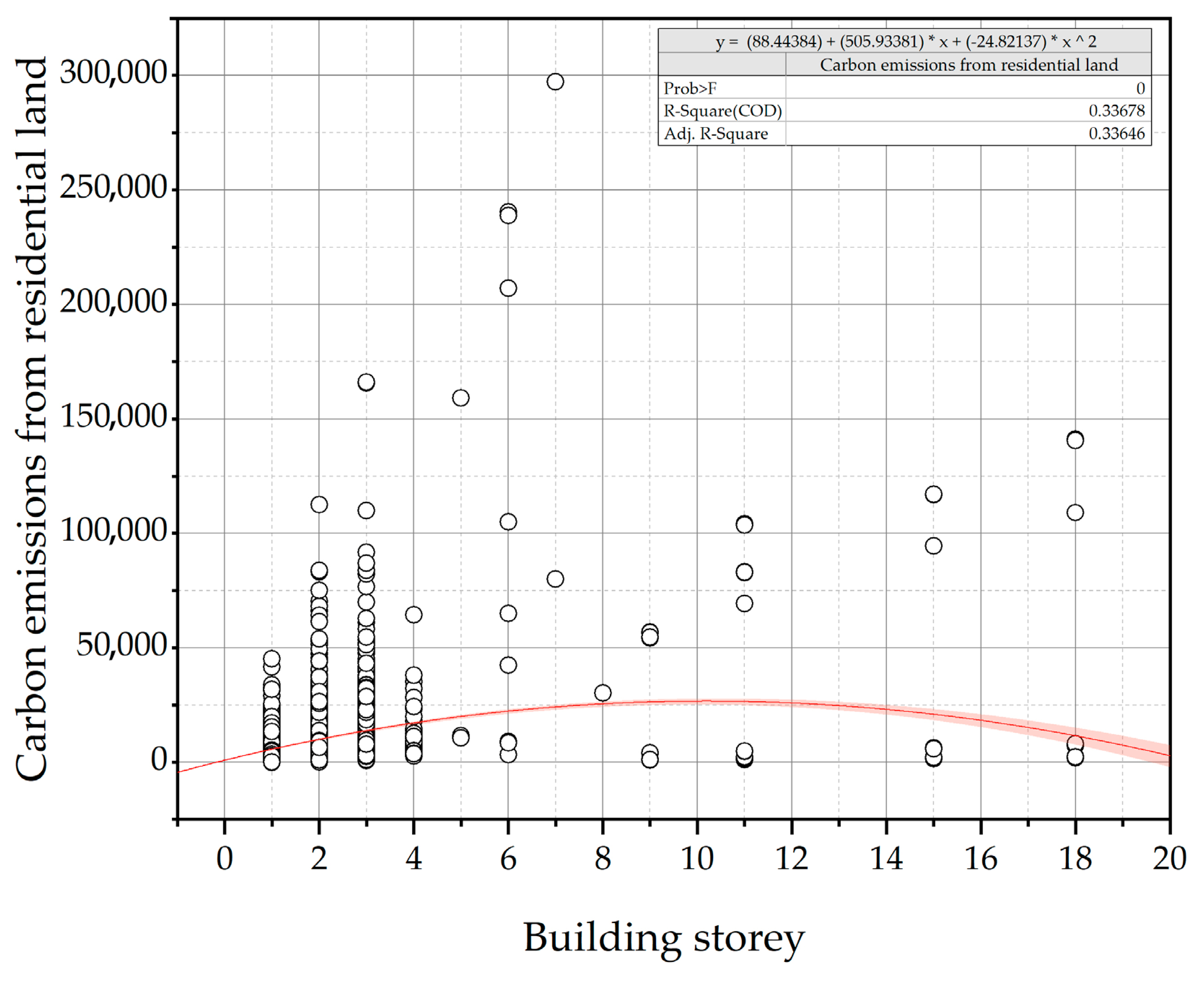 (6) Building storey |
 (7) Building orientation | 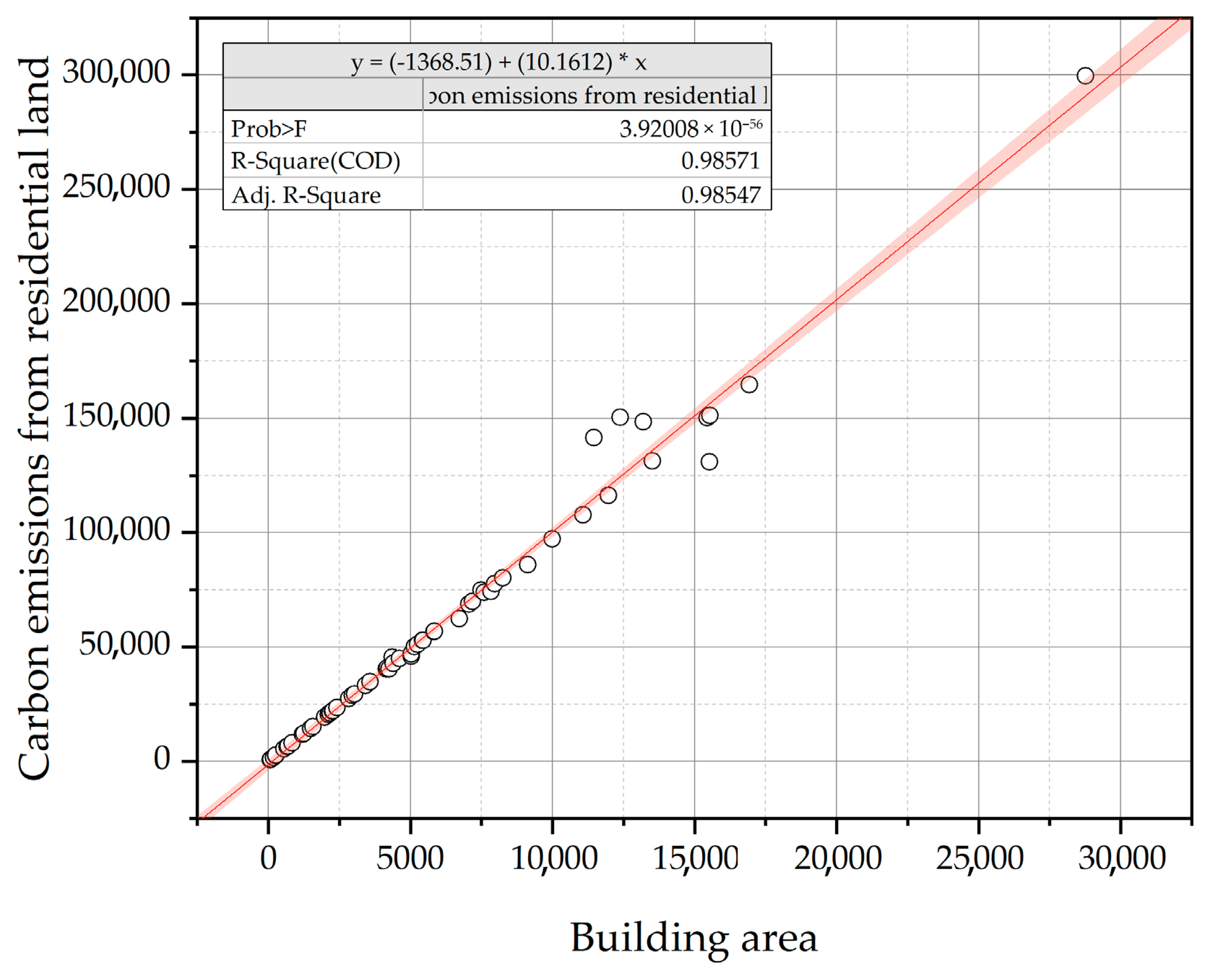 (8) Building area | |
 (9) Construction time | ||
Notes: | ||
| Spatial Form Elements | Analysis Chart | ||
|---|---|---|---|
| Land use elements | 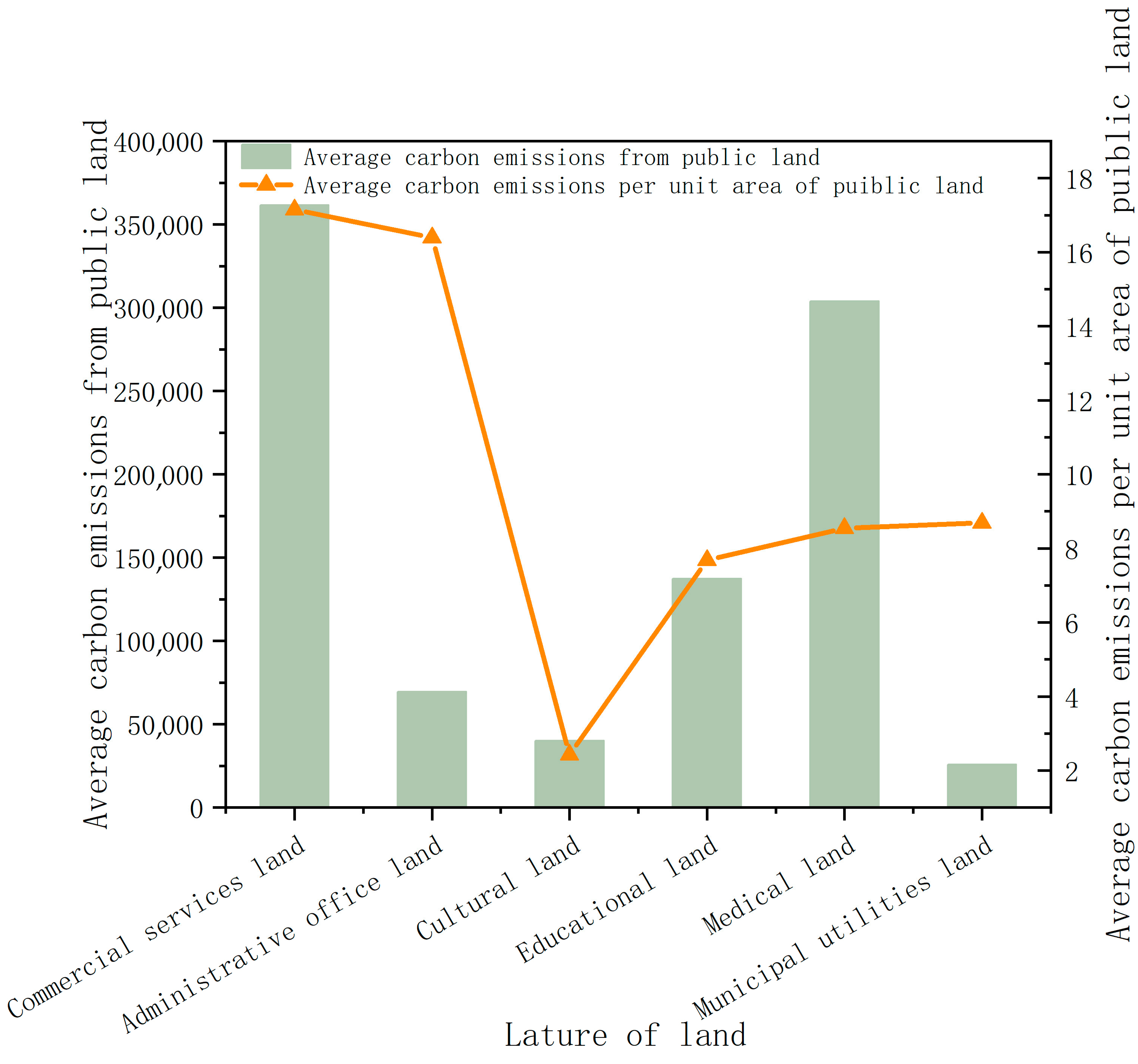 (1) Nature of land | 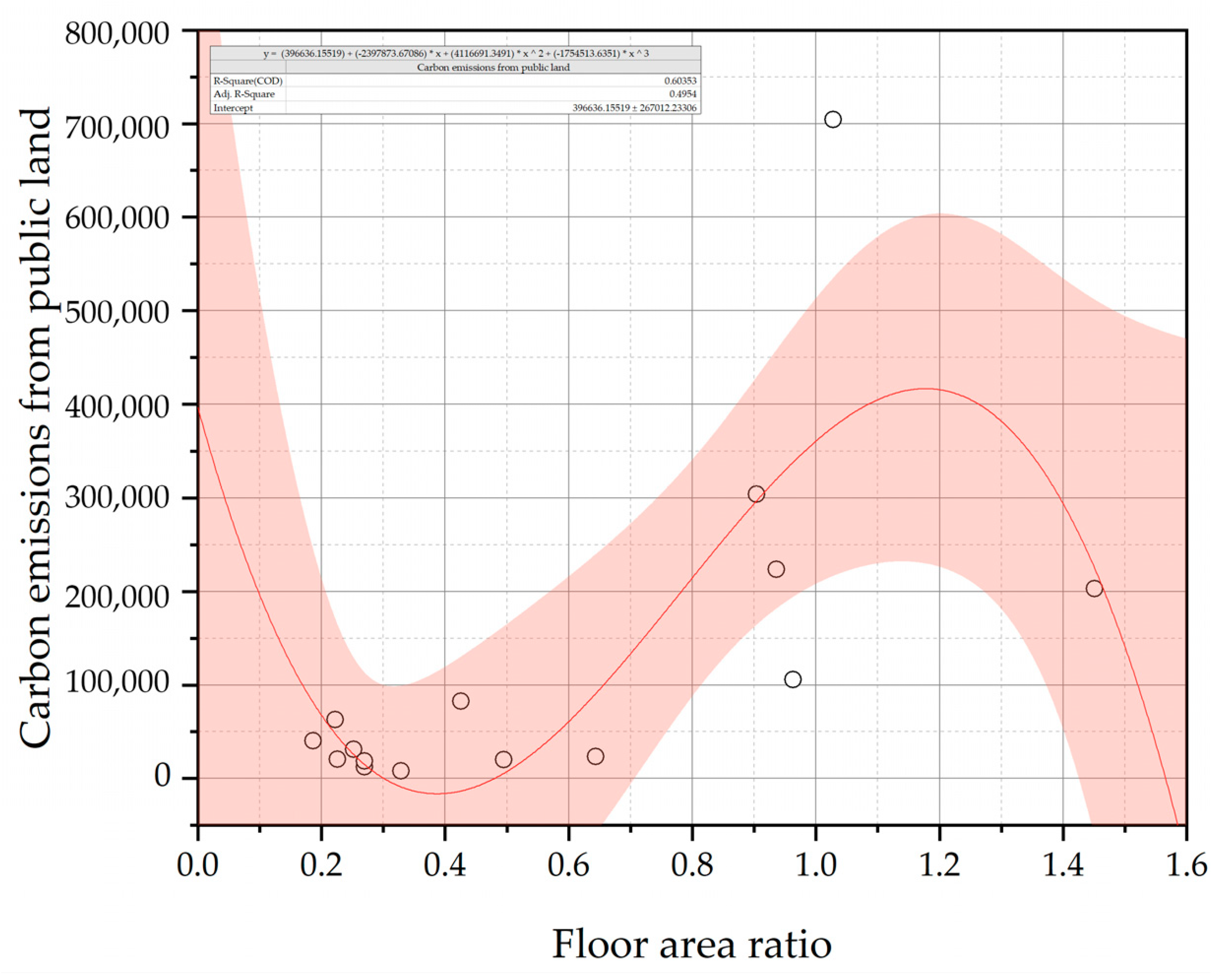 (2) Floor area ratio | 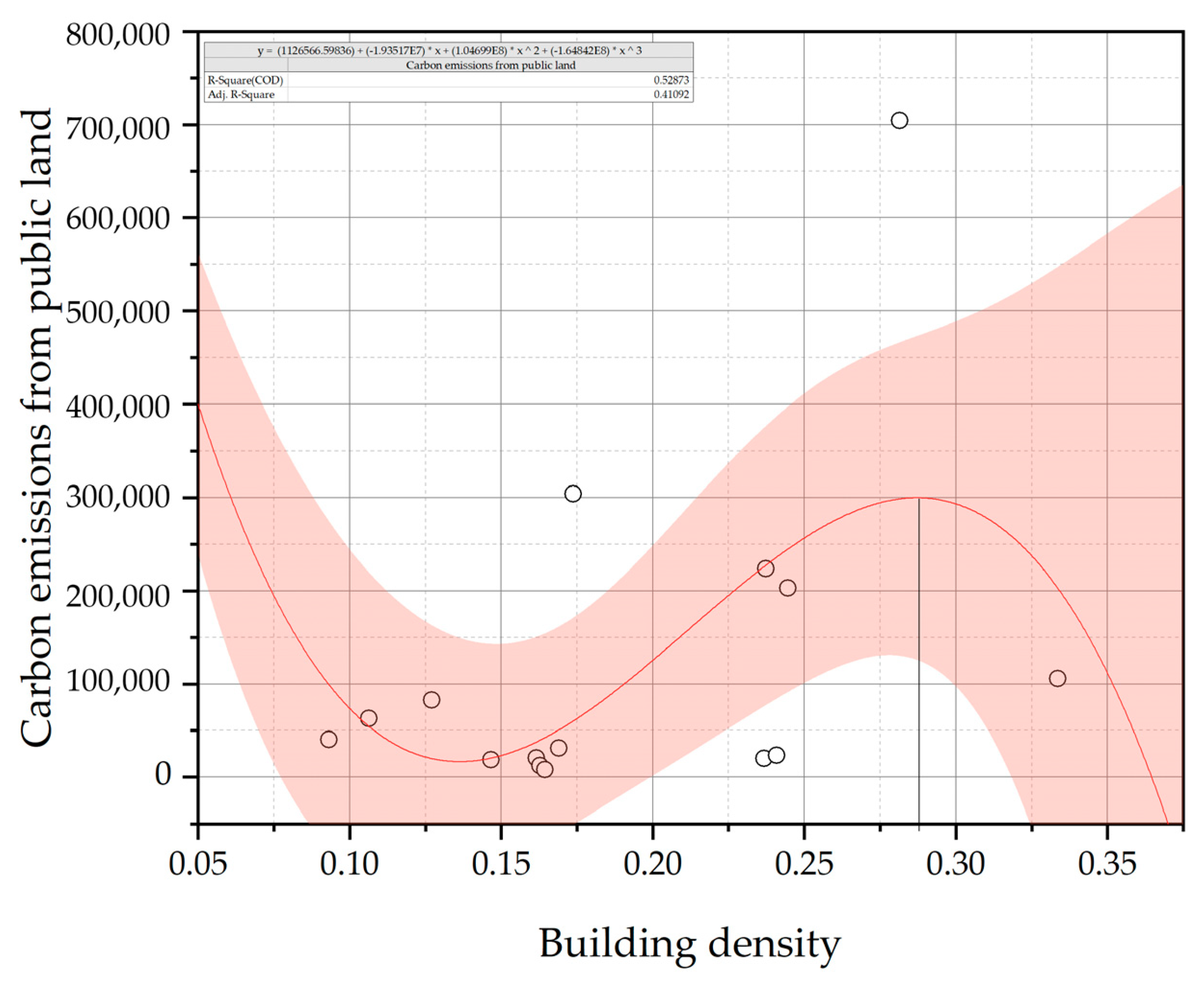 (3) Building density |
| Building elements |  (4) Building shape coefficient |  (5) Building storey | 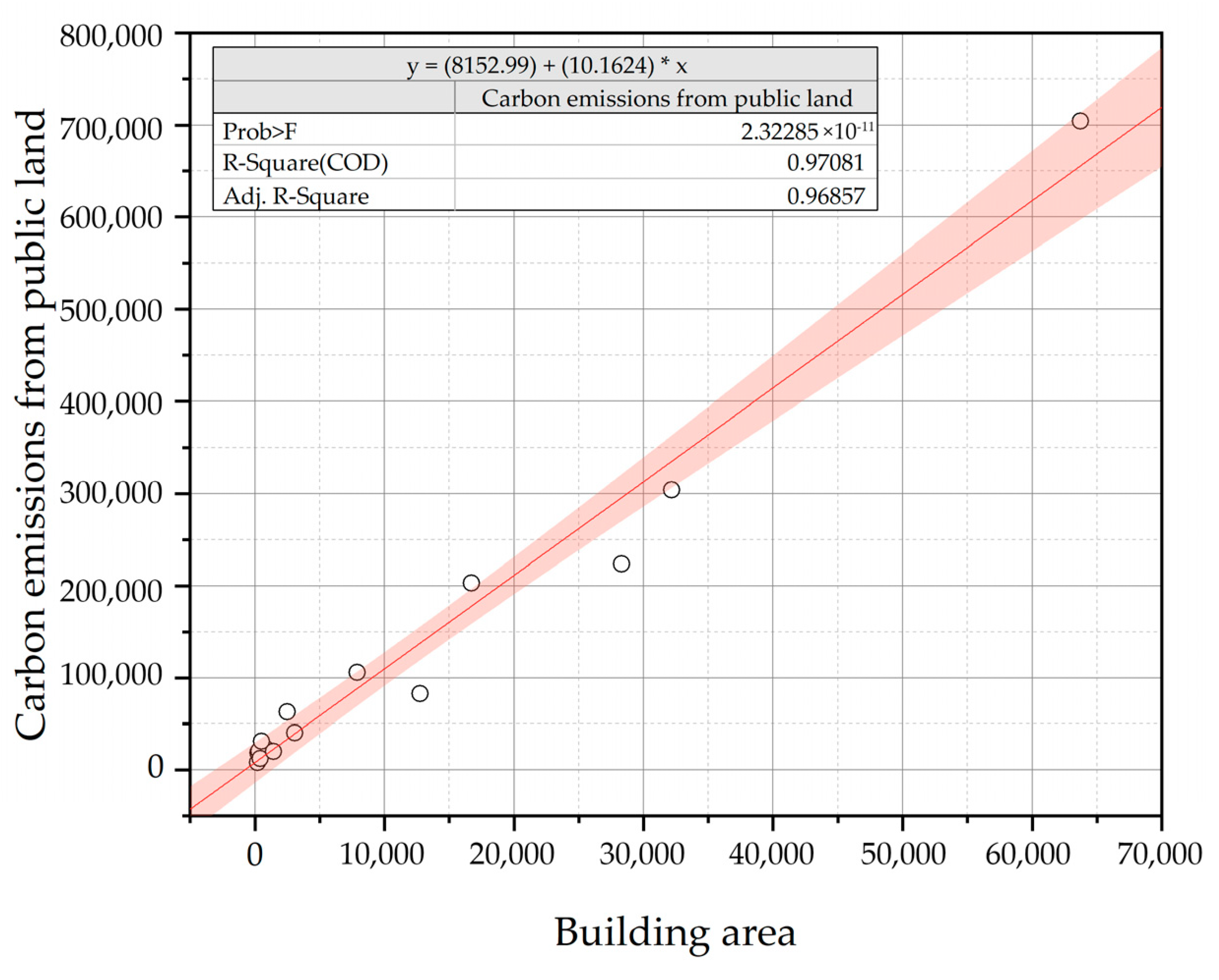 (6) Building area |
Notes:  | |||
| R2 Score | Mean Squared Error | Mean Absolute Error | |
|---|---|---|---|
| Training | 0.9813 | 0.4117 | 0.3249 |
| Testing | 0.9738 | 0.4639 | 0.4240 |
| R2 Score | Mean Squared Error | Mean Absolute Error | |
|---|---|---|---|
| Training | 0.9181 | 0.3093 | 0.3453 |
| Testing | 0.7248 | 0.1775 | 0.3787 |
Disclaimer/Publisher’s Note: The statements, opinions and data contained in all publications are solely those of the individual author(s) and contributor(s) and not of MDPI and/or the editor(s). MDPI and/or the editor(s) disclaim responsibility for any injury to people or property resulting from any ideas, methods, instructions or products referred to in the content. |
© 2023 by the authors. Licensee MDPI, Basel, Switzerland. This article is an open access article distributed under the terms and conditions of the Creative Commons Attribution (CC BY) license (https://creativecommons.org/licenses/by/4.0/).
Share and Cite
Xu, Y.; Sun, L.; Wang, B.; Ding, S.; Ge, X.; Cai, S. Research on the Impact of Carbon Emissions and Spatial Form of Town Construction Land: A Study of Macheng, China. Land 2023, 12, 1385. https://doi.org/10.3390/land12071385
Xu Y, Sun L, Wang B, Ding S, Ge X, Cai S. Research on the Impact of Carbon Emissions and Spatial Form of Town Construction Land: A Study of Macheng, China. Land. 2023; 12(7):1385. https://doi.org/10.3390/land12071385
Chicago/Turabian StyleXu, Yao, Liang Sun, Bo Wang, Shanmin Ding, Xichen Ge, and Shuangrong Cai. 2023. "Research on the Impact of Carbon Emissions and Spatial Form of Town Construction Land: A Study of Macheng, China" Land 12, no. 7: 1385. https://doi.org/10.3390/land12071385
APA StyleXu, Y., Sun, L., Wang, B., Ding, S., Ge, X., & Cai, S. (2023). Research on the Impact of Carbon Emissions and Spatial Form of Town Construction Land: A Study of Macheng, China. Land, 12(7), 1385. https://doi.org/10.3390/land12071385






